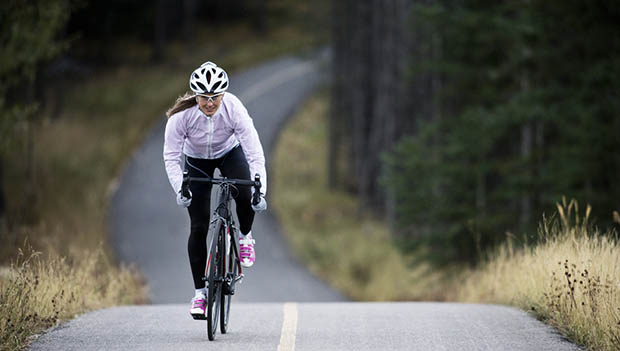
Ah, finally. It’s the time of the year when the long cycling season wraps up in parallel with the trees turning color and losing their leaves. Hot, summer sunshine is replaced by cooler temperatures and shorter days, which naturally means there’s a shift in the way we schedule rides and approach our training sessions.
This in-between period is a sweet spot for most cyclists. It’s not as hot as the summer, and it’s not quite cold enough to second-guess heading out for a ride. It encourages long, less-serious miles with friends, as well as reconnecting with your love of cycling—not squeezing out every ounce of fitness from each ride.
From warming up beforehand to checking the weather, here are 10 cycling training tips to keep in mind as the weather gets cooler.
Give Your Bike a Tune-Up
Depending on how much you ride (and how the conditions are in your area), it’s always a good idea to give your bike a tune-up twice a year. After a long peak summer season of training and racing, your bike is likely much overdue for a little TLC. This includes a complete wash, truing your wheels, adjusting your brakes, derailleurs and shifters, and cleaning and lubing (or replacing) your chain. If you can do all of this yourself, great—but if not, head to your local bike shop and let the professionals take care of it.
Also, remember as the weather gets cooler, there’s often more moisture in the air and on the road. Clean your drivetrain more often, and make sure you’re regularly lubing your chain.
Warm up Beforehand
There’s no reason to jump on the bike and expect to warm up when it’s chilly outside. Not only will this lead to an uncomfortable experience, but your on-the-bike performance with suffer, too. Be gentle on your system by going for a light indoor trainer spin to get the body moving, warm up with a cup of coffee or tea and leave the house with your layers already on—you can shed them as needed.
Season-Proof Your Bike
The ideal scenario would be to have a summer racing bike and a winter training bike, but that’s not a reality for most of us. If this isn’t you, remove your summer racing tires and opt for a more heavy-duty tire with a bit more tread to protect against debris and moisture on the road. Also, install a mudguard behind your seat post to keep any of the spray from your rear tire from soaking your kit.
Reconnect With Your Local Cycling Club
Cooler weather is a great excuse to head out for a less performance-oriented ride with friends. Reconnect with your local cycling club or check the calendar at your LBS and see when it heads out on Thursday evenings and Saturday and Sunday mornings. Not only is it easier to hold a conversation when you’re not hammering in 95-degree heat, but your friends will take turns pulling through the cooler wind.
Cool-Weather Attire
Everyone has their own preference on how they dress for cooler-weather rides. Some opt for a base layer below their jersey, with nothing more than a pair of arm warmers and a light vest. Others prefer a heaver long-sleeved cycling jacket and insulated bibs. No matter which you choose, always leave the house prepared for the conditions at hand.
Not sure where to start or want to mix things up this year? We put together a step-by-step cold-weather apparel guide that describes all the basics and how to incorporate each piece into your ensemble.
Set up Your Trainer
It’s only a matter of months (or even potentially weeks) before a cold front comes in and brings the first snow of the season. Instead of being caught off guard and unable to ride, set up your pain cave with plenty of time to reconnect your sensors, mount your TV and update Zwift (or whatever training tool you use). Include a few indoor spins in your training plan this fall to work out any kinks and replace or purchase whatever you need.
Stay Hydrated
Just because you’re not sweating through a hot summer ride doesn’t mean you can place less of an emphasis on keeping up with your hydration. It’s just as important during the cooler times of the year, as you’re still losing fluids even if you don’t feel like you are. To encourage drinking, fill an insulated bottle up with warm water, or even schedule a stop at a local coffee shop for some warm liquids (as if you needed another reason).
Be Seen
The shorter days obviously means there are less sunlight-filled hours of potential training time, so if you’re planning an early-morning ride or a spin after work, make sure you’re heading out with both a headlight and a taillight (and that they’re both charged). Take it one step further and opt for a high-vis wind vest and socks, too.
Stay Closer to Home
We’re all for heading out and exploring new roads by bike, but rain, snow and debris from high winds can sometimes lead to unknown road conditions—especially as fall begins to turn to winter. Staying closer to home not only keeps you on more familiar roads, but it also means you’re closer to help in case you have a mechanical issue, run out of food or crash while out on a ride.
Check the Weather
The weather during this time of year can be pretty unpredictable. Always check the forecast the night before the ride for major trends, as well as the morning of the ride to see if anything has changed before throwing your leg over the saddle. As mentioned above, it’s important to dress for the conditions, and even if it’s looking clear, it’s always a good idea to pack a vest and a pair of arm warmers for emergencies.
READ THIS NEXT: How to Dress for Fall Cycling


